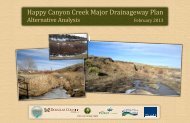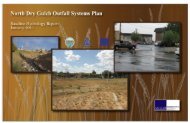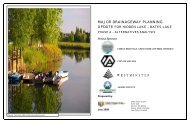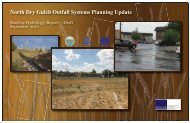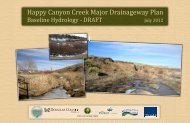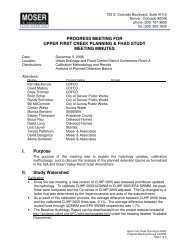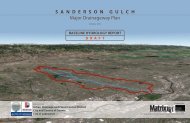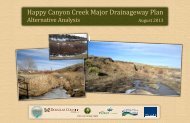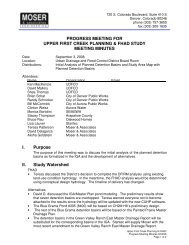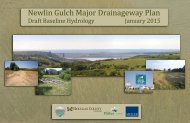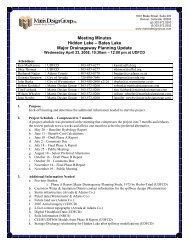Final Baseline Hydrology Report - October 2012 - Urban Drainage ...
Final Baseline Hydrology Report - October 2012 - Urban Drainage ...
Final Baseline Hydrology Report - October 2012 - Urban Drainage ...
Create successful ePaper yourself
Turn your PDF publications into a flip-book with our unique Google optimized e-Paper software.
Sanderson Gulch Major <strong>Drainage</strong>way Plan<br />
<strong>Baseline</strong> <strong>Hydrology</strong> <strong>Report</strong> <strong>October</strong> <strong>2012</strong><br />
2.6 Environmental Assessment<br />
Wetlands and Riparian Areas<br />
Wetland and riparian areas along the Sanderson Gulch and North Sanderson Gulch corridors are currently<br />
very limited. Figure E-1 in Appendix E delineates significant potential wetland and riparian areas based on<br />
the National Wetlands Inventory, 2009 aerial photography and field observations. Two recent projects<br />
within Sanderson Gulch Park between W. Florida Avenue and S. Zuni Street have re-established a natural<br />
riparian channel edge for approximately 1,600 feet of the channel. In those reaches of Sanderson Gulch<br />
contained within linear parks and open space, significant additional potential exists to reestablish wetlands<br />
and riparian areas. The 2009 Denver Parks and Recreation Gulch Master Plan (Matrix, 2009) recognized<br />
this potential and proposes establishing a sizeable riparian buffer along the channel edge throughout the<br />
Denver reach.<br />
Threatened and Endangered Species<br />
The U.S. Fish and Wildlife Service (USFWS) currently lists the following threatened and endangered<br />
species for Denver and Jefferson Counties (http://www.fws.gov/endangered/):<br />
Denver County Status Jefferson County Status<br />
Piping plover Threatened Mexican spotted owl Threatened<br />
Least tern Endangered Piping plover Threatened<br />
Ute ladies’-tresses orchid Threatened Least tern Endangered<br />
Preble’s jumping mouse Threatened Colorado Butterfly plant Threatened<br />
Pawnee montane skipper Threatened<br />
Canada Lynx<br />
Threatened<br />
Preble’s jumping mouse Threatened<br />
The entirety of the Sanderson Gulch watershed is within the Denver metropolitan Block Clearance Zone for<br />
Ute ladies’-tresses orchid, Preble’s meadow jumping mouse and the Colorado butterfly plant. These<br />
species should not be a concern for projects within the watershed.<br />
USFWS on-line maps currently indicate that the Canada lynx, Mexican spotted owl and the Pawnee<br />
montane skipper are not known or believed to occur within the Denver portion of the watershed east of<br />
Sheridan Avenue. Bird habitat resources for Piping plover, Least tern and the Mexican spotted owl within<br />
the Sanderson Gulch watershed and along the Sanderson and North Sanderson Gulch waterways are<br />
currently limited because the watershed is fully urbanized and there is little riparian corridor adjacent to the<br />
channels. Future design projects will require more detailed assessments of any potential threatened and<br />
endangered species habitat resources within the project limits.<br />
Landfills and Contamination<br />
There are many landfills in the lower Sanderson Gulch area. Figure E-2 in Appendix E presents known<br />
historical landfill areas within the Sanderson Gulch watershed. The source of this information is the City<br />
and County of Denver GIS. A review of environmental records and consultation with Denver Environmental<br />
Health staff indicates that likelihood of encountering severe environmental hazards is relatively low.<br />
As part of the <strong>Final</strong> DRAFT Mississippi Gulch Outfall Alternatives Analysis and Scoping Study, December<br />
2010, an initial file review was conducted of the regulatory-listed environmental issues potentially affecting<br />
Sanderson Gulch between Lipan Street and the South Platte River in Denver. A letter report dated <strong>October</strong><br />
15, 2009 by Matrix Environmental Services, LLC., (MES) to the City and County of Denver presented a<br />
summary of the sites identified during a regulatory search that are adjacent to or up-gradient of the outfall<br />
and may have impacted the drainageway. A First Search regulatory review of sites within a 1-mile radius of<br />
the outfall was conducted. The only sites identified that may have a current impact on the outfall area are<br />
the potential landfills located along lower Sanderson Gulch. Based on the potential presence of this landfill<br />
and because of the highly industrialized areas surrounding the Study Area, a materials management plan<br />
should be implemented for Sanderson Gulch during any intrusive development activities.<br />
Denver Radium Site<br />
UDFCD has been made aware of the potential for radium near the Sanderson Gulch outfall. However, the<br />
threat has been cleared according to research as summarized in the <strong>October</strong> 15, 2009 report from Matrix<br />
Environmental Services:<br />
“The Denver Radium Site consists of more than 65 properties along the South Platte River Valley in Denver,<br />
Colorado. In the early 1900s, radium was used for commercial purposes including cancer therapy and<br />
research. Several ore processing facilities located along the South Platte River provided a domestic source<br />
to meet the radium market demands. In the early 1920s, radium, vanadium, and uranium ores were<br />
discovered in Africa, and the Denver radium industry dried up. Radioactive soils and debris were<br />
abandoned at the processing facilities and the locations of the sites and contaminated debris piles were<br />
forgotten. In 1979, the EPA re-discovered the Denver Radium Site during a review of old documents and<br />
the State spearheaded several studies to locate the Denver Radium Site properties. The Denver Radium<br />
Site was added to the National Priority List (NPL) of Superfund Sites in September 2003 and was divided<br />
into 11 Operable Units (OUs).’<br />
“Contaminants at the site included radium, thorium, arsenic, lead, and radon gas, and contaminated media<br />
included air, soils, and groundwater. Clean-up was conducted at all 11 OUs and included the removal of<br />
contaminated soil to a permanent offsite disposal site, installation of radon gas ventilation systems, and<br />
contaminant stabilization. In September 2006, the <strong>Final</strong> Closeout <strong>Report</strong> for the Denver Radium Site was<br />
completed and the properties were deemed suitable for redevelopment.’<br />
“The Sanderson Gulch outfall is down-gradient of the Denver Radium Site Operable Unit 3 (OU3), bordering<br />
OU3 on the south. Remedial actions at OU3 began in August 1989 and were originally completed in<br />
September 1991. A phased approach to the cleanup allowed onsite businesses to maintain operations<br />
during the excavation and shipment of 63,672 tons of contaminated materials from OU3. Some areas of<br />
OU3 were not excavated and approximately 5,868 cubic yards of contaminated soils were originally left<br />
onsite beneath the groundwater table, near water lines, under South Jason Street, around the Packaging<br />
Corporation of America building, and along South Platte River Drive.’<br />
“In 2001, groundwater was collected from a monitoring well located within the OU3 boundary. The well had<br />
elevated levels of gross alpha and gross beta contamination. In 2003, an additional five monitoring wells<br />
were installed around OU3 and sampled for radionuclide contamination. Of the five new wells, only two<br />
wells exhibited radionuclide contamination. These wells were located within or immediately down-gradient of<br />
the contaminated soils that were left onsite. A final round of groundwater monitoring was completed in<br />
February 2004 and a final report was submitted in May 2004. In the 2008 five-year review of the Denver<br />
18



